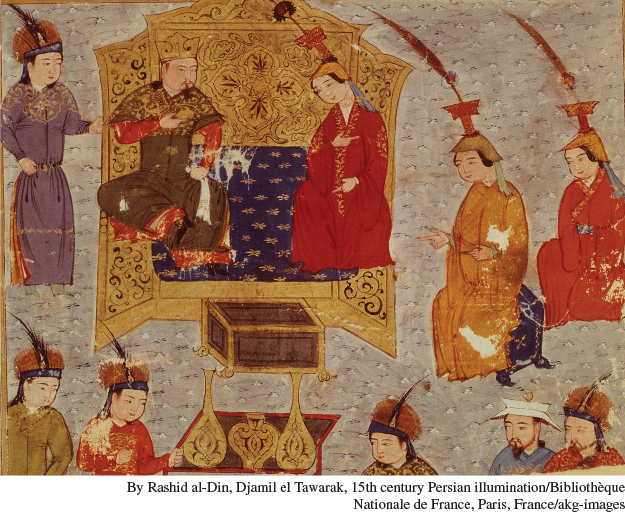Persia and the Mongols
A second great civilization conquered by the Mongols was Islamic Persia. There the Mongol takeover was far more abrupt than the extended process of conquest in China. A first invasion (1219–1221), led by Chinggis Khan himself, was followed thirty years later by a second assault (1251–1258) under his grandson Hulegu (HE-
Every town and every village has been several times subjected to pillage and massacre and has suffered this confusion for years so that even though there be generation and increase until the Resurrection the population will not attain to a tenth part of what it was before.18
Guided Reading Question
▪COMPARISON
How was Mongol rule in Persia different from that in China?
The sacking of Baghdad in 1258, which put an end to the Abbasid caliphate, was accompanied by the massacre of more than 200,000 people, according to Hulegu himself.
AP® EXAM TIP
Pay attention to these results of Mongol rule over Persia.
Beyond this human catastrophe lay the damage to Persian and Iraqi agriculture and to those who tilled the soil. Heavy taxes, sometimes collected twenty or thirty times a year and often under torture or whipping, pushed large numbers of peasants off their land. Furthermore, the in-migration of pastoral Mongols, together with their immense herds of sheep and goats, turned much agricultural land into pasture and sometimes into desert. As a result, a fragile system of underground water channels that provided irrigation to the fields was neglected, and much good agricultural land was reduced to waste. Some sectors of the Persian economy gained, however. Wine production increased because the Mongols were fond of alcohol, and the Persian silk industry benefited from close contact with a Mongol-ruled China. In general, though, even more so than in China, Mongol rule in Persia represented “disaster on a grand and unparalleled scale.”19
Nonetheless, the Mongols in Persia were themselves transformed far more than their counterparts in China. They made extensive use of the sophisticated Persian bureaucracy, leaving the greater part of government operations in Persian hands. During the reign of Ghazan (haz-ZAHN) (1295–1304), they made some efforts to repair the damage caused by earlier policies of ruthless exploitation by rebuilding damaged cities and repairing neglected irrigation works. Most important, the Mongols who conquered Persia became Muslims, following the lead of Ghazan, who converted to Islam in 1295. No such widespread conversion to the culture of the conquered occurred in China or in Christian Russia. Members of the court and Mongol elites learned at least some Persian, unlike most of their counterparts in China. A number of Mongols also turned to farming, abandoning their pastoral ways, while some married local people.
AP® EXAM TIP
Note these differences between the end of Mongol rule in Persia and in China.
When the Mongol dynasty of Hulegu’s descendants collapsed in the 1330s for lack of a suitable heir, the Mongols were not driven out of Persia as they had been from China. Rather, they and their Turkic allies simply disappeared, assimilated into Persian society. From a Persian point of view, the barbarians had been civilized, and Persians had successfully resisted cultural influence from their uncivilized conquerors. When the great Persian historian Rashid al-Din wrote his famous history of the Mongols, he apologized for providing information about women, generally unmentioned in Islamic writing, explaining that Mongols treated their women equally and included them in decisions of the court.20 Now Persian rulers could return to their more patriarchal ways.
